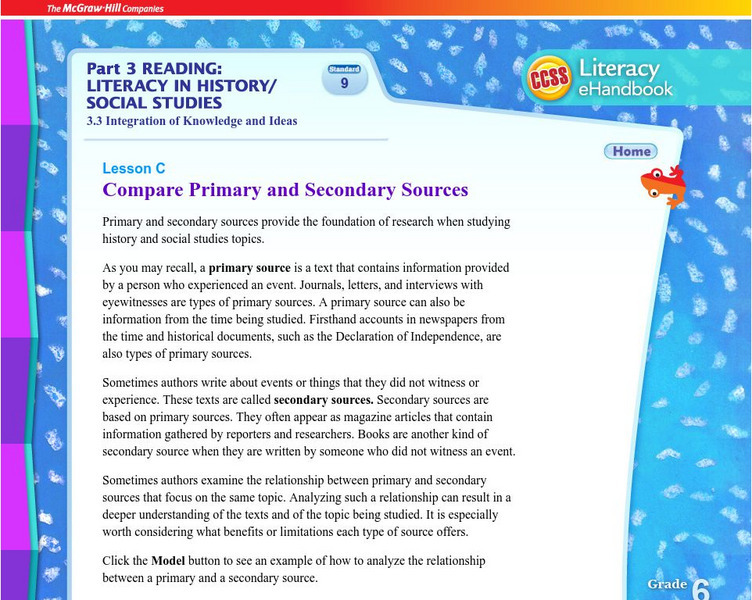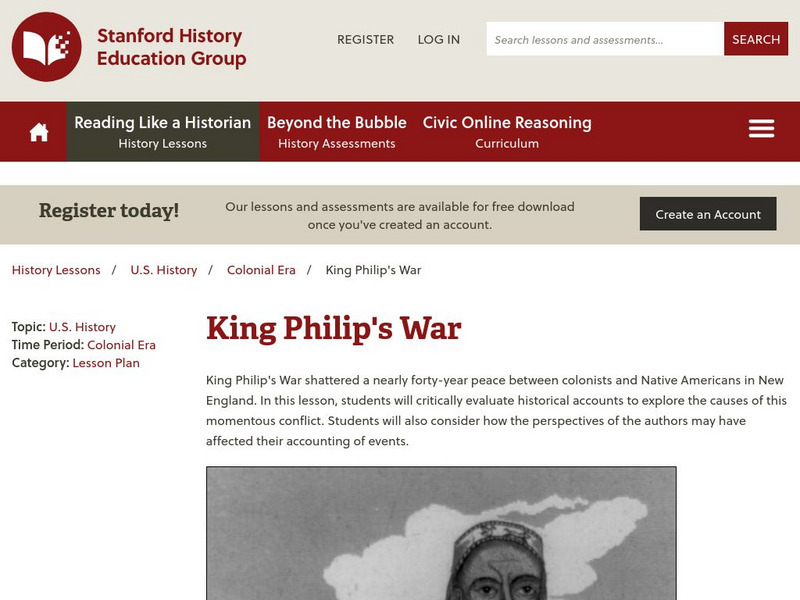Hi, what do you want to do?
Duke University
Duke University Libraries: Finding Primary Sources
Finding primary sources can be difficult and confusing at times. This site provides a list of history databases, rare books and manuscripts, and research guides for those looking for primary resources such as diaries, letters,...
Library of Congress
Loc: Kindergarten Historians: Primary Sources in an Early
If you've ever wondered how early elementary students develop historical thinking skills, check out this lesson with a group of kindergarten students. The Class of 2025 demonstrated their educational readiness while engaged in analyzing...
Library of Congress
Loc: Sourcing a Document: The First Thanksgiving
In this activity, young scholars discuss the reliability of a painting of the First Thanksgiving to introduce the idea that is crucial to consider a source's date.
US National Archives
Docsteach: A Revolution, a Reaction and a Reform: National History Day
Students will analyze primary source documents related to the National History Day (NHD) theme for 2011-12: Revolution, Reaction, Reform in History, determine how the documents are connected to the theme, and evaluate the effectiveness...
Curated OER
Mc Graw Hill: Compare Primary and Secondary Sources
Learn how to analyze and compare the relationship between a primary and a secondary source.
Roy Rosenzweig Center for History and New Media
Teaching History: Interactive Historical Thinking Poster (Secondary)
This is an interactive historical thinking poster. History is an argument about the past. Constructing a narrative about history involves several tasks: Analyzing Primary Sources, Examining Source Information,Using Evidence to Support...
US National Archives
Nara: Teaching With Documents: Volstead Act and Related Prohibition Documents
Refer to the documents pertaining to Prohibition on this site when using the accompanying activities. In addition practice analyzing primary source documents with the worksheet that is provided.
Other
Using Sources Effectively
This site provides hints and guidelines on how to effectively use sources.
Stanford University
Sheg: Document Based History: Reading Like a Historian: Thomas Nast
[Free Registration/Login Required] Learners read primary source documents to solve a problem surrounding a historical question. This document-based inquiry lesson allows students to analyze two cartoons drawn by Thomas Nast, and to chart...
Stanford University
Sheg: Document Based History: Reading Like a Historian: Shays' Rebellion
[Free Registration/Login Required] Students read primary source documents to solve a problem surrounding a historical question. This document-based inquiry lesson allows students to gain a more nuanced understanding of how Americans...
Stanford University
Sheg: Document Based History: Reading Like a Historian: Maine Explosion
[Free Registration/Login Required] Young scholars solve a problem surrounding a historical question by reading primary source documents. When the USS Maine exploded in Havana Harbor, triggering the Spanish-American War, the New York...
US National Archives
Docsteach: The New Deal: Revolution or Reform?
Students will analyze primary sources related to the New Deal. They will analyze specific documents to determine if overall the New Deal represents a revolution or a reform in our history.
US National Archives
Docsteach: The Settlement of the American West
Students will analyze primary sources with an eye for cause-and-effect relationships.They will identify the roles of government policy and technological improvements in the settlement of the West, and explain their impact on Native...
Other
New York State Library: Student Activity: Primary Versus Secondary Sources
Read about the Railroad Strike of 1877 using three excerpts from textbooks and three original newspaper articles. Compare and contrast the information in the primary and secondary sources.
US National Archives
Docsteach: What Kind of Leader Was General Douglas Mac Arthur?
In this activity, students will analyze video clips, photographs, and written documents related to General Douglas MacArthur to explore the controversy surrounding his career, especially the decision by President Harry S. Truman to...
US National Archives
Docsteach: National Monuments Express National Values
In this activity, students will identify and analyze national monuments and buildings to discover how they represent American people, ideas and institutions.
National Humanities Center
National Humanities Center: Toolbox Library: America in 1850: Frederick Douglass
The National Humanities Center presents collections of primary resources compatible with the Common Core State Standards - historical documents, literary texts, and works of art - thematically organized with notes and discussion...
Stanford University
Stanford History Education Group: Castro and the United States
[Free Registration/Login Required] Lesson in which students analyze primary source material to consider different ways Castro viewed the United States. Includes teacher materials, student materials, PowerPoint and original documents.
Other
Object of History: Guide to Doing History With Objects
Explore the dimensions of America's rich history by taking a detailed look at objects from our past. Examine stories, important moments, and the evolution of the American people via primary documents, photos, and other artifacts.
US National Archives
Docsteach: Senators' Pay in the First Congress
In this activity, young scholars will analyze a primary source document to find relevant historical data and calculate how much United States Senators were paid in the first Federal Congress.
US National Archives
Docsteach: Extending Suffrage to Women
In this activity, students will analyze documents pertaining to the women's suffrage movement as it intensified following passage of the 15th Amendment that guaranteed the right to vote for African American males. Documents were chosen...
Stanford University
Sheg: Document Based History: Reading Like a Historian: New Deal Sac
[Free Registration/Login Required] A structured academic controversy opportunity to peruse and analyze documents to ignite a debate over the success or failure of the New Deal.
Stanford University
Sheg: Document Based History: Reading Like a Historian: King Philip's War
[Free Registration/Login Required] Lesson in which students analyze original documents to evaluate the conflict between colonists under King Philip and Native Americans.
Alabama Learning Exchange
Alex: The Diary of Anne Frank: How Would I Survive?
Lesson to be used following the reading of play The Diary of Anne Frank or the book Anne Frank, The Diary of a Young Girl. Students explore the Anne Frank Center website. In groups of five, students analyze the residents of the Secret...



























